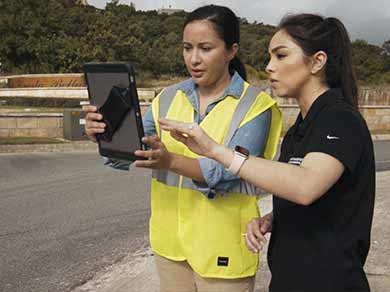Texas pride isn’t just rodeos, barbecue, and breakfast tacos. Our pride extends to our roads, too – including a multi-year initiative to improve mobility and safety that traffic experts across the nation are paying close attention to.
The initiative aims to bring all public-facing TxDOT spaces into compliance with modern accessibility requirements. An Americans with Disabilities Act (ADA)-focused inventory of curb ramps was conducted around the turn of the millennium, but it was time for an update, according to Pete Krause, Section Director for TxDOT’s Design Division, Landscape Architecture Section. “We wanted to rebuild the inventory in a meaningful way, expanding its scope and taking into account new technologies to build future projects.”
As an initial step in the plan, three collections teams inventoried and examined all TxDOT-owned spaces across 254 Texas counties, logging status and issues for each one. Starting in 2019, their investigation included pedestrian right-of-way, public TxDOT buildings, travel information centers, and rest areas. The process also involved holding focus groups, talking with government offices and elected officials, and collaborating with citizens about their public spaces.
The comprehensive identification of accessibility problems included items that most users would easily overlook. A sidewalk that is broken, heaved, or too steep may be easy to traverse for most pedestrians, yet impossible for those with limited mobility. Sidewalks need curb ramps. Transit stops need paved space sufficient for wheelchair-using passengers to exit, so they do not need to navigate grass or dirt. Crosswalk buttons should be positioned so they are accessible to everyone.
The inventory required driving the roads of the state highway system and logging data on tablets. The statewide comprehensive survey, which is 99 percent complete, has recorded data on over 4,500 miles of sidewalk, 131,920 curb ramps, 6,156 bus stops, and 52,000 crosswalk push buttons.
“We were honored to be there from the beginning, helping both conceive the program and serving as one of the collection teams,” says John Tyler, P.E., Vice President at Pape-Dawson Engineers As the teams collected detailed data, they entered it into a centralized platform called the TxDOT Comprehensive Accessibility Program (TCAP) Web Application.
After a successful launch earlier this year, the TCAP Web App is currently functional for an initial group of internal users. The plan, says Pete, is for TxDOT to steadily widen its reach. “Soon we’ll have a remediation tracker, so we can record not just the problems, but when things get fixed.” Also on the horizon is an important tie-in to the Civil Rights Division that will allow the tracking of user-submitted accessibility grievances.
The TCAP Web App is already helping prioritize the projects that get funded first to ensure money is reasonably allocated across Texas. Prioritizing projects is a complex business and is based on problem severity and frequency of use. “There’s no one right answer on these questions,” says John, “but we’re trying to help make the best decisions on how to spend taxpayer money throughout the state.” Equity, too, is a consideration. “We look at what populations are likely to be more pedestrian-oriented, so we can make sure to serve them well,” Pete adds. The complexity of the overall context can also play into
when a problem gets fixed. After all, if an accessibility issue is part of a bigger infrastructure project, the timing of its remediation might be influenced by factors other than its standing on the TCAP Web App.
The data collected in this significant stride forward may hold promise for wider uses, too. “This project addresses ADA needs specifically, but it will also have important insights for ways we can help reduce pedestrian crashes,” Pete says. In the future, it may provide a single source for data that can inform modifications to existing infrastructure, as well. If a restaurant needs to change its driveway, for example, the TCAP Web App may help connect to state-level approvals, permitting, and other processes.
TxDOT’s comprehensive accessibility data collection across the entire state is a pioneering effort never attempted in a state at this scale. “It allows us to find the true need, allocate money toward it so it gets fixed, and then track it — all in one place,” says Pete. “It has been a monumental undertaking,” John says with satisfaction, “and we’re starting to see the results.” As it proves its worth in coming years, the TCAP Web App will become another source of Texas pride, as well as an example for other states to follow.
Download the article here: Industry Insights 2022-Issue6: TxDOT’s Data-Enabled Push Toward Accessibility
